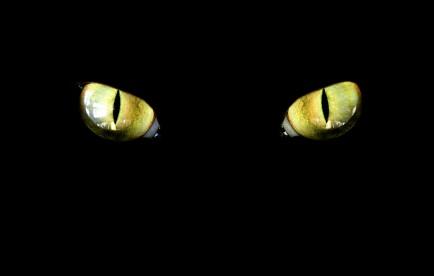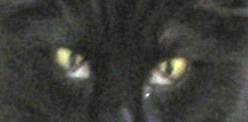Vision and Eye Problems in Cats

Cats have unusual eyes in that their pupil is vertical and not round as in humans. Comparatively speaking the eyes of a cat are much larger than those of a person. Also, cats see much better at night than humans do. This is because there is a layer of cells called the tapetum lucidum behind the cat retina that causes light to be reflected back onto the retina thereby providing it with more light.
Unlike humans, cats also have a third eyelid. The function of this is to help lubricate and clean the eye. Under normal circumstances the third eyelid isn't visible (or at least not much of it is visible) unless your cat is ill.

Cat With Visible Third Eyelid
For example, take a look at the photo of the cat that has much of it's third eyelid visible (the white portion in the inside corners of the eye is the third eyelid). Strangely, she just woke up one morning and her third eyelid was showing. She was immediately taken to the veterinarian's office and it turned out she had a fever. In a few days the fever was gone and her eyes were completely back to normal again.
Anytime you notice a change in the visibility of your cat's third eyelid you should take your cat to the vet. Normally this eyelid isn't visible unless your cat is ill. The uppermost photo shows the normal eyes of a cat. In it you can see how much of the third eyelid is typically visible in a healthy cat. Also, keep in mind that when cats are resting you will sometimes see the third eyelid but as soon as the cat becomes alert the third eyelid will retract to its normal position.
Cats and Visual Acuity
Cats see objects that are far away better than they can see objects that are very close. They also have excellent peripheral vision. Cats also have much more difficulty seeing still objects. They can see objects that are moving much better. I have always believed that this is one reason that cats splash water out of the bowl before drinking it. I think they like to get the water moving so they can see how deep it is so they don't stick their face down in the water.
Cats and Color Vision
Like humans, cats have both rods and cones in their retina. Rods are responsible for the ability to determine the intensity of light (how light or dark it is) and cones are responsible for color vision. The more rods in the eye the better the animal can see in dim light. The more cones in the eye the better the animal is at seeing colors.
Cats have lots of rods, but very few cones. What this means is that they can see well in dim light but they have limited color vision (as compared to humans). Cats do see some colors, however. In addition, humans have 3 different kinds of cones in their eyes and cats only have two different kinds. No one knows for certain exactly what colors cats see but it is thought that they are red-green colorblind, meaning that they see red and green as the same color.
They must be able to discriminate some colors that it doesn't seem like they should given the research, because I have noticed that cats often have a preference for certain toys that are identical except for their color. Hot pink seems to be a favorite (at least among my cats).
Some Common Eye Problems in Cats
Conjunctivitis
Conjunctivitis is an inflammation of the outer layer of the eye (the conjunctiva). Conjunctivitis in cats can be caused by a bacterial infection in the conjunctiva, and sometimes occurs in cats suffering from a viral respiratory infection. One or both eyes may be affected. The affected eye will be red, with a discharge. If your cat has these symptoms you will need to contact your veterinarian. Usually you will be given antibiotic ointment to place in your cat's eyes.
Sometimes your vet will take an eye culture to determine the cause of the infection because the type of antibiotic given will depend on which type of bacteria is responsible for the infection.
Cataracts
Like people, as cats age they become prone to age related eye changes such as cataracts. You will see this more often in cats with diabetes. Often no treatment is needed, but if your cat's vision is significantly impaired, surgery may be needed to remove the cataracts.
Over Production of Tears
Some cats overproduce tears and this spills over and leads to facial staining. Have your veterinarian check your cat out to make sure he or she isn't having an eye problem. If your vet has checked your cat's eyes out and found nothing wrong and this is normal for your cat then I wouldn't worry about it. Some cats just normally produce more tears than is usual. However, if there is any change in your cat's tear production or your cat's eyes you should have your cat checked out by a veterinarian.
Sometimes your vet can give you eye drops to put in your cat's eyes to help with watery eyes.
Under Production of Tears
Then there are cats with the opposite problem and their eyes are too dry because they don't produce enough tears. Your vet can tell you if your cat has this problem and can give you special drops to place in your cat's eyes each day. You may notice your cat squinting if he or she has this problem. Don't use drops for humans in your cat's eyes.
Cross Eyes
Some cats are cross-eyed. In particular some breeds of cats are more likely to be cross-eyed than others. For example, Siamese cats are more likely to be cross-eyed than other breeds of cats. It doesn't seem to cause them any distress.
Injuries
Cats that are outdoors often get into fights and their eyes may get injured. Anytime your cat's eyes are injured you need to seek immediate veterinary attention for your cat to prevent a loss of vision in the affected eye. Eye injuries can be quite serious.
